Li S.Z., Jain A.K. (eds.) Encyclopedia of Biometrics
Подождите немного. Документ загружается.

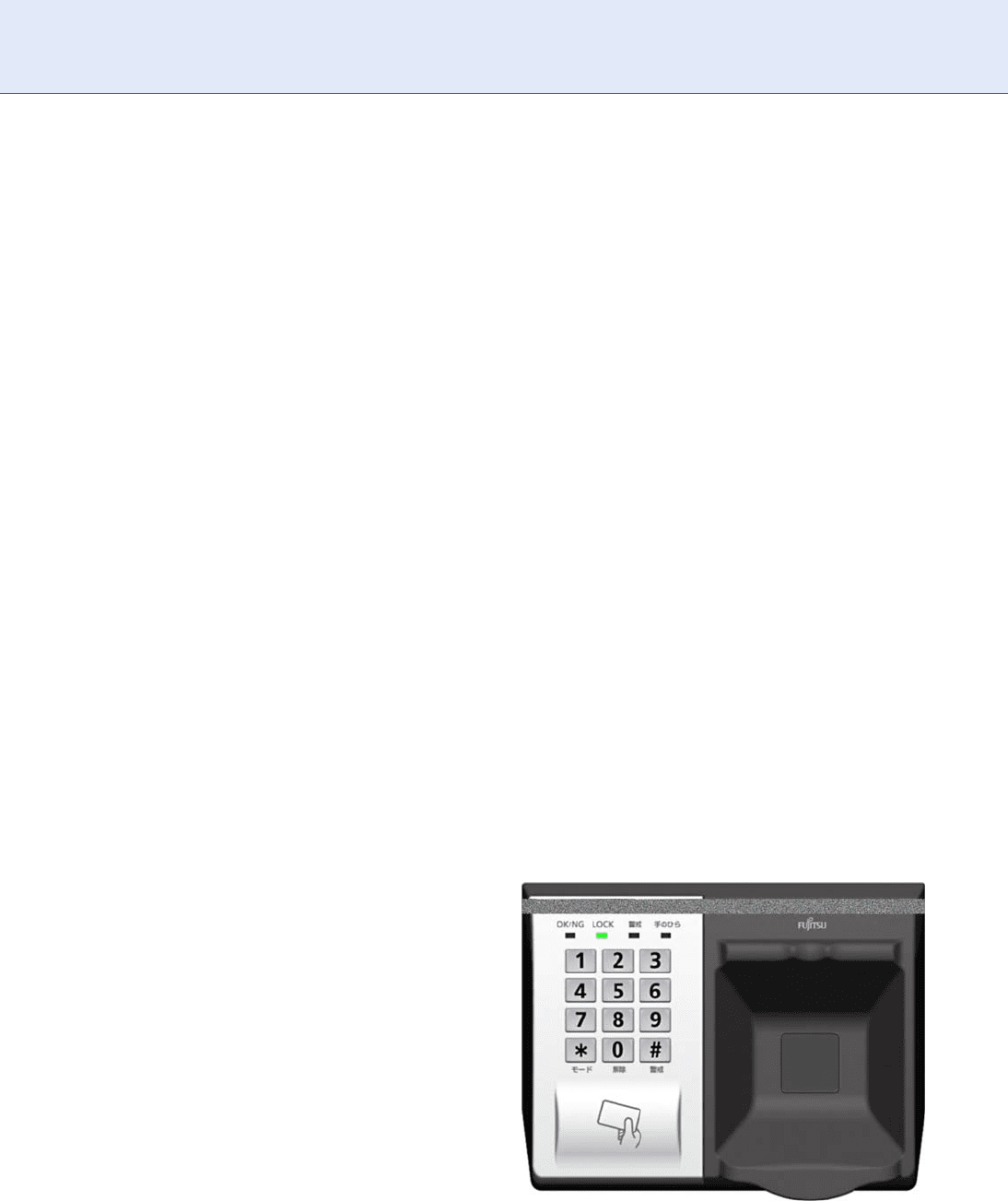
Palm vein authentication technology was evaluated
in Round 6 of Comparative Biometric Testing (CBT)
by International Biometric Group (IBG) in 2006.
CBT of IBG evaluates the accuracy and usability of
biometric products using scenario-based testing, and
strives to understand biometric performance in the
real-world conditions. CBT Round 6 was the first
major independent test to evaluate multiple vascular
recognition technologies. Such assessments are typi-
cally based on a comparison of recognition samples
and enrollment templates. In the case of palm vein
authentication, approximately 40,000 [8] genuine
comparisons and 50 million imposter comparisons
were executed.
Results of the IBG study revealed that palm vein
authentication performed exceptionally w ell in the
failure to enroll (FTE) testing; only one person out of
1,290 did not finish the enrollment process given
the test criteria, a failure rate was of only 0.08%.
This extremely low rate indicates that palm vein au-
thentication is highly applicable virtually for every
individual, and does not impose any physiological
restrictions when users interface with the device. This
further indicates that palm vein authentication is us-
able, is easy for the users to learn, and is ideal for use in
high-volume and large-scale applications.
Most importantly, palm vein authentication was
effective when tested for authentication accuracy.
The false acceptance rate (FAR) and false rejection
rate (FRR) were extremely low, outperforming other
products in the evaluation at standard and high secu-
rity. The perf ormance differences between same- and
different-day transactions were also minimal. There-
fore, after the users learned how to use the device, they
were able to use it successfully on an ongoing basis.
These data further confirm that palm vein authentica-
tion is highly accurate and has optimal usability, both
of which are relevant to real-world conditions.
Implementation
In actual implementation, palm vein patterns can
be stored on a smartcard. The matching between the
palm vein pattern on the smartcard and the one cap-
tured for authentication can also be executed on the
smartcard. Because the palm vein pattern is protected
against external attacks by an antitampering function
of the smartcard, users can handle their own palm vein
patterns safely.
Application
Door Security Systems
Palm vein authentication sensors have been installed
on many access control units over the world (Fig. 3).
They can be used to control entry and exit into and out
of rooms and buildings. For those applications, the
combination of the following features of palm vein
authentication means that it provides the optimum
system: a hygienic contactless unit ideal for use in
public places, user-friendly operation that requires
people to simply hold their palms over a sens or, and
a method that makes impersonation difficult.
In view of the P ersonal Information Protection
ActthatwentintofulleffectinJapaninApril2005,the
Department of Planning, Information and Management
of the Univ ersity of Tokyo Hospital began using palm
vein authentication for a new security system to control
room access. The security levels of the system were
divided into three access levels: ac c ess to the administra-
tive room, the development room, and the server room.
A palm vein authentication access control unit has been
installed at the entrance of each room. The system has
been able to restrict an individual’s entry in stages.
Palm Vein. Figure 3 Palm vein access control unit
implemented by Fujitsu.
1030
P
Palm Vein
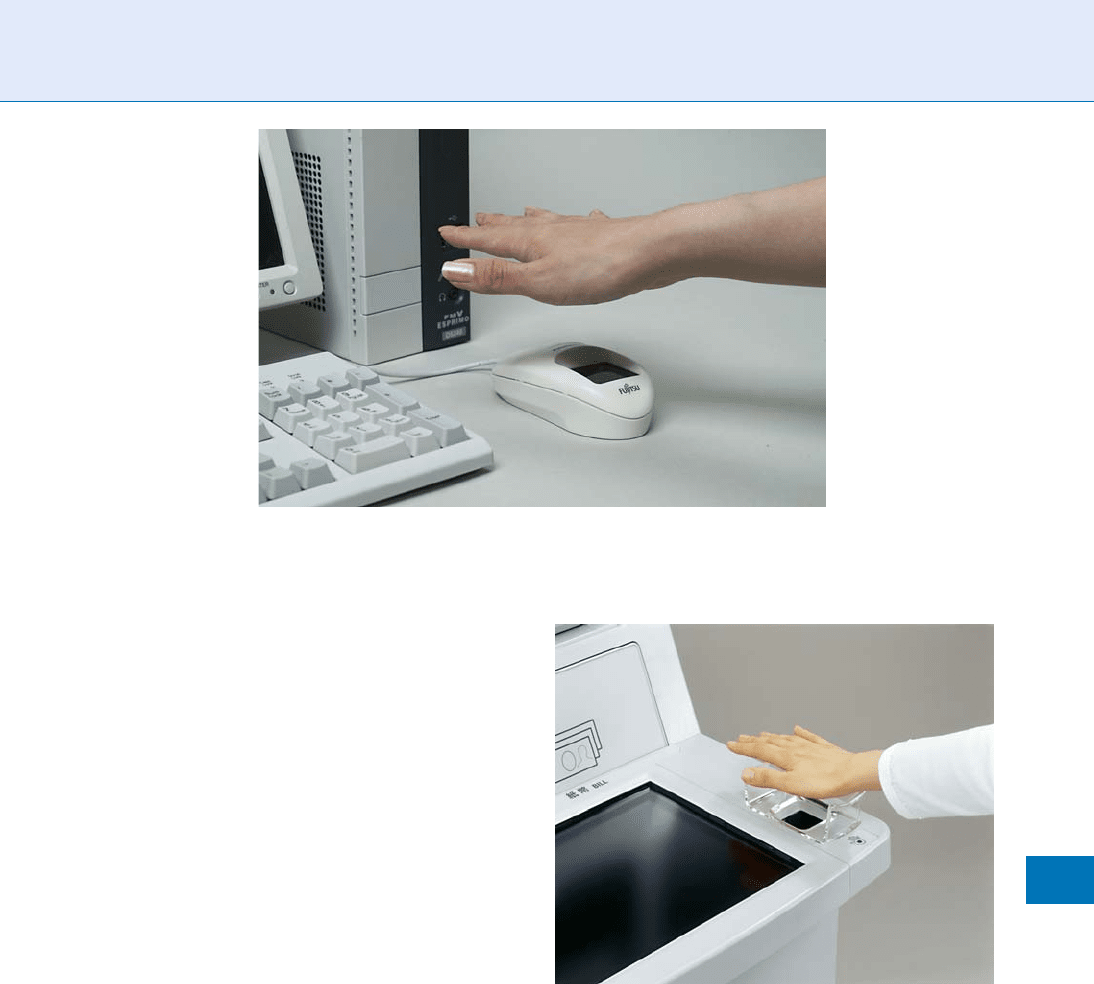
Login Authentication
Palm vein authentication sensors can be integrated
into PC mouse (Fig. 4). Using a mouse as a palm
vein authentication sensor offers convenience and
space-saving advantages.
Many companies and government agencies have an
internal information system which handles sensitive
personal data. Using a mouse with an integrated
palm vein authentication sensor enables advanced,
high-level security for system log-ins, beyond mere
IDs and passwords, with the high accuracy and reli-
ability of palm vein authentication.
Financial Services
In 2003, Japan saw a rapid increase in financial damage
caused by fraudulent withdrawals from bank accounts
by spoofing the identity with fake bankcards that were
made using information from stolen or skimmed
cards. It was a significant social problem. This had
caused a sharp increase in the number of lawsuits
taken out by victims against financial institutions
for their failure to control information used for per-
sonal identification. The ‘‘Act for the Protection of
Personal Information’’ came into effect in May 2005,
and in response, financial institutions in Japan have
been focusing on biometric authentication methods
together with smartcards, as a way to reinforce the
security of personal identification. Palm vein authenti-
cation is the form of biometric authentication that was
most quickly introduced for customer confirmation at
banking facilities. It has been used since July 2004,
before the act came into effect.
When used for financial ser vices, a user’s palm vein
pattern is registered at a bank counter and stored on a
smartcard. This has the advantage of allowing users to
carry their own palm vein pattern around with them,
Palm Vein. Figure 4 PC mouse containing palm vein authentication sensor.
Palm Vein. Figure 5 ATM with palm vein authentication
sensor.
Palm Vein
P
1031
P

and lets them manage the usage of their smartcard.
To verify ATM transactions, palm vein pattern of a
user’s is captured by a palm vein authentication sensor
on the ATM (Fig. 5). The captured palm vein pattern is
transferred to the user’s smartcard, and this with the
one transferred from the sensor are compared on the
smartcard. Finally, only the matching result and not
the regist ered palm vein pattern of the user is output
from the smartcard.
In additi on to Japan, Brazil has also already decided
to adopt palm vein authentication to identify users in
ATM banking transactions. Banco Brad esco S.A., the
largest private bank in Latin America, has been on
testing palm vein authentication. After researching
various biometric technologies, Bradesco chose palm
vein authentication because of its outstanding features,
such as its high level of verification accuracy and the
fact t hat it is noninvasive and hygienic, making it easier
to be accepted by customers of the bank.
Healthcare
Palm vein authentication is being deployed through-
out t he Carolinas HealthCare System (CHS) in the
United States as par t of a solution to effectively regis-
ter patie nt information and ensure that the proper
medical care is given to the rig ht person, while pro-
tecting their medic al record and privacy from i dentity
theft and insurance fraud. To implement the system,
CHS developed a unique hand guide as a sensor.
The h and guide is adapted perfectly for a hospital
environment since it incorporates a pediatric plate
that adapts the guide so it can be used with young
children, and can accommodate all the patients of
the CHS.
The Sapporo Hospital of Keiyu Association in
Japan also adopted palm vein authentication for their
electronic medical records system for patient authenti-
cation. Patients who are to undergo an operation,
register their palm vein patterns before the operation
and the registered palm vein pattern and the palm vein
pattern scanned from the patient on the day of the
operation are compared. This confirms that the patient
is the same as the one whose records have been input in
the electronic medical recording system by the doctor
in charge, and avoids the wrong patient being operated
on, which might occur if two patients have the same
name for example.
Some applications for healthcare could be realized
because the contactless type of palm vein authentica-
tion is excellent in terms of hygiene.
Other Uses
The Chiba Institute of Technology in Japan deployed a
student ID system that combines palm vein authenti-
cation and multifunctional smartcards to verify the
identity of stude nts, and lets them securely access
their academic transcripts and other personal records
through information kiosk terminals installed in vari-
ous locations around the campus.
An examination service can use palm vein bio-
metrics to authenticate the identity of examination
candidates. Palm vein authentication is viewed as pref-
erable to other modalities due to the reliability; it is not
easy to steal palm vein images of others, making spoof-
ing difficult.
Summary
Palm vein authentication uses vein patterns on the
palm of a person as personal information. It is a highly
secure technology because palm vein pattern is infor-
mation contained within the body of someone. It is
also hig hly accurate because palm vein patterns are
complex and unique to each individual. Moreover, its
contactless feature gives it a hygiene advantage over
other authentication technologies. Many users of prac-
tical applications have highly evaluated this authenti-
cation method and experienced no psychological
resistance to using it. This is good reason for develop-
ing new products for various solutions, starting with
financial solutions followed by access control units and
then login sensors.
Related Entries
▶ Vascular Image Data Format, Standardization
▶ Vascular Network Pattern
▶ Vei n
References
1. Rice, J.: Apparatus for the Identification of Individuals. US
Patent 4,699,149 (1985)
1032
P
Palm Vein

2. Totty, M.: A better idea. Wall St. J. Oct. 24. (2005)
3. Kim, J.G., Xia, M., Liu, H.: Extinction coefficients of hemoglobin
for near-infrared spectroscopy of tissue. IEEE Eng. Med. Biol.
Mag. 24, 118–121 (2005)
4. Wray, S., Cope, M., Delpy, D.T., Wyatt, J.S., and Reynolds, E.O.:
Characterization of the near infrared absorption spectra of cyto-
chrome aa3 and haemoglobin for the non-invasive monitoring
of cerebral oxygenation. Biochim. Biophys. Acta. 933(1),
184–192 (1988)
5. Cope, M.: The application of near infrared spectroscopy to non
invasive monitoring of cerebral oxygenation in the newborn
infant. Ph.D. thesis, University College London, Appendix B
316–323 (1991)
6. Editorial Board for Visualization: Techniques of Biological
Information Visualization Techniques of Biological Information
(in Japanese), Corona Publishing Co., Ltd., p. 86 (1997)
7. Watanabe, M., Endoh, T., Shiohara, M., Sasaki, S.: Palm vein
authentication technology and its applications, In: Proceedings
of Biometrics Symposium. 37–38 (2005)
8. International Biometric Group: Comparative Biometric Testing
Round 6 – Public Report. http://www.biometricgroup.com/
reports/public/reports/CBT6_report.htm. Accessed 19 Mar,
2009
9. Sasaki, S., Hiroaki Kawai, H., Wakabayashi, A.: Business expan-
sion of palm vein pattern authentication technology, FUJITSU
Sci. Tech. J. 41(3), 341–347 (2005)
Palm Vein Authentication
▶ Palm Vein
Palm Vein Authentication Sensor
▶ Palm Vein Image Sensor
Palm Vein Image Sensor
MASAKI WATANABE
Fujitsu Laboratories Ltd., Kawasaki, Japan
Synonyms
Palm vein authentication sensor; Palm vein scanner
Definition
The palm vein image sensor is used for palm vein
authentication. The device captures an image of the
vein pattern in the palm by emitting near-infrared rays
that are absorbed by the deoxygenated hemoglobin in
the veins and then reflected back to the device for
image capturing.
The palm vein image sensor is commercially avail-
able as a device for more secured personal identification.
Example applications include door security systems, PC
login management systems, financial services security
systems, and hospital patient confirmation systems.
Introduction
The palm vein image sensor is used for palm vein auth-
entication, a vascular pattern recognition technolog y.
The device uses the vein pattern of the palm as person-
al identification data. Therefore, the palm vein image
sensor must scan the position of the veins with the
highest degree of accuracy.
The technology for noninvasive scanning of blood
vessels is primarily categorized as in vivo meas ure-
ment. In this field, near-infrared spectroscopy (NIRS)
and imaging has been investigated for the last ten years
[1]. The palm vein image sen sor was developed based
on this NIRS technology.
Infrared scanning of the pattern of subcutaneous
blood vessels for the identification of individuals w as
first disclosed in Rice’s patent in 1985 [2]. In 2001,
Peterson et al. patented a device for palm vein authen-
tication [3], in which a plurality of light-emitting ele-
ments is arranged in an array with light-detecting
elements in a flexible mat. The mat was intended
to be put into a device to be grasped by the hand of the
person to be identified following to Stiver’s patent [4].
The device comprises of an elongated transparent
cylindrical exterior shell and scans the hand grasping
the device. In 2003, Fujitsu realized a box-type device
for practical use and it was launched in Japan the
following year. In 2008, Snowflake Technologies [5]
released a prototype in which a palm vein sensor is
embedded to the upper part of equipment for a door
security system. The palm vein image patterns can also
be simultaneously acquired with palmprint images and
employed to achieve improvement in performance of
palmprint authentication as detailed in [12].
Palm Vein Image Sensor
P
1033
P

Hemoglobin in vessels is grouped into two types:
oxygenated hemoglobin that is in ar teries and contains
oxygen; and deoxygenated hemoglobin that is in veins
and does not contain oxygen, and in particular, absorbs
light with a wavelength of about 760 nm [6, 7]. When
the palm of the hand is illuminated by near-infrared
light, the rays will be scattered by structures under the
surface of the ski n. Much of this illumination will be
reflected bac k towards the illumination source, how-
ever little will be reflected from the veins since these
absorb near-infrared.
Palm vein patterns are preferably acquired using
the reflection method [3] and also in commercially
available products from Fujitsu [9] and Snowflake
[5], whereby the palm is illuminated from the front
and the image is also captured from the front. If the
transmission method is used, whereby the palm is
illuminated from the back of the hand and the image
is captured from the front, a very strong light would
be needed.
To realize this imaging method, the palm vein
image sensor must have both of an illumination func-
tion and imaging function by near-infrared rays. The
illumination function must emit light in a wavelength
of about 760 nm and the imaging function must have
sufficiently high resolution to distinguish the vein pat-
tern. In the reflection method, because the direction of
illumination is the same as that of image capturing, the
illumination device and the imaging device are com-
pactly integrated.
A palm vein image sensor should ideally scan
as broad a palm area as possible for keeping high
accuracy of palm vein authe ntication because the
human palm has an extensive a nd complex vein
pattern that contains sufficient information to identi-
fy an individual from among many people. But some
kinds of sensors which scan a par tial area of a palm
would be designe d fo r rea son s of usability such as the
Stiver’s patent.
Implementation
The research and development efforts for the compact
palm vein image sensors have been confined to few
commercial vendors. Therefore only very limited tech-
nical details are available for the palm vein image
sensors. In Fujitsu’s implementation [8, 9], the palm
vein image sensor is in the shape of a small box 35 mm
deep by 35 mm wide by 27 mm high. Image capturing
is executed in a contactless manner. Users do not touch
the sensor; they only have to hold their palms above it.
The user places his or her hand below an optical reader,
which scans the palm.
To obtain a clear image of the palm vein pattern,
imaging is controlled according to the movement and
position of the hand above the sensor or below the
sensor, and illumination is controlled recognizing the
light around the sensor. Video-rate scanning is ty pical-
ly employed for the convenience in the palm vein
authentication so that users do not have to stop the
hand for authentication.
Any imaging devices such as CMOS sensors or
CCD sensors will be used for the capturing but it
must have sensitivities of near-infrared rays. It should
be also assembled not to capture except for the
reflected near-infrared rays from inner of the hand
using such as a polarizing filter, an optical filter cutting
off visible lights, and so on.
The contactless method, which is adopted by both
of sensors, eliminates the concerns of users who are
sensitive about hygiene or who are reluctant to come
into direct contact with publicly used devices. It also
enables the identification method to be used in envir-
onments where a high standard of hygiene is required,
such as in medica l facilities or food factories.
Regarding security, a data encryption function for
the palm image should be also provided. This ensures
that image output is protected from any unauthorized
access or tampering.
Other possible substantiation of palm vein image
sensor has been also announced. NEC Corporation
developed the world’s first contactless multi-modal
finger recognition technology [10]. The new device
quickly scans two forms of biometric information,
fingerprints and vein patterns of finger. They proved
that the device might also be adapted to recognize skin
and vein patterns from any region of a human body. As
an example, the possibility of a scanning system cus-
tomized to analyze and authenticate both fingerprint
and palm characteristics was also shown.
Evaluation
Comparative Biometric Testing (CBT) by the Inter-
national Biometric Group (IBG) evaluates the accu-
racy and usabilit y of biometric products using
1034
P
Palm Vein Image Sensor
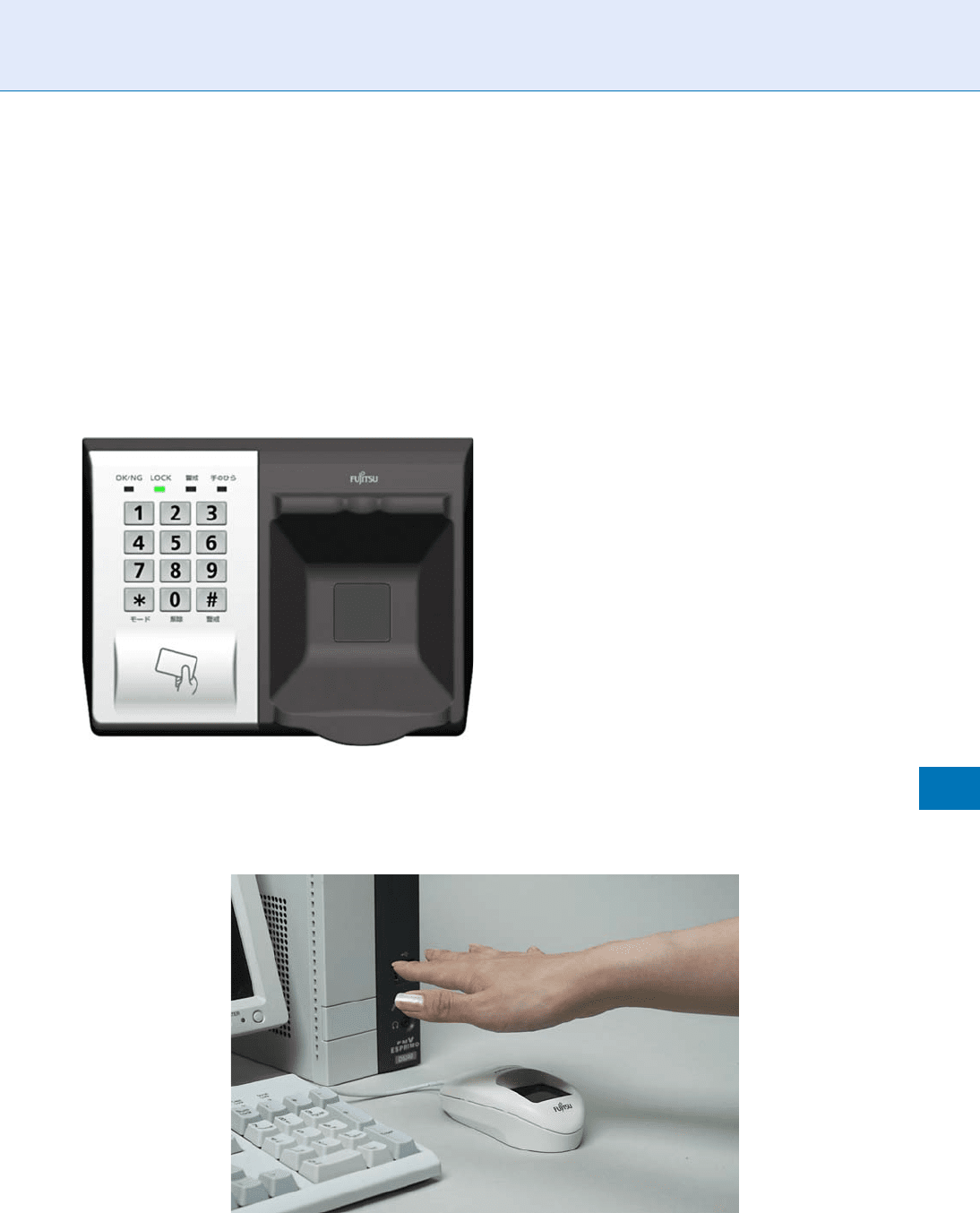
scenario-based testing, and strives to understand bio-
metric performance in real-world conditions. Round 6
of the testing in 2006 evaluated palm vein authentica-
tion technology using Fujitsu’s sensor.
The results of the IBG study revealed that palm vein
authentication using this sensor performed exception-
ally well in the failure to enroll (FTE) testing [11].
Authentication accuracy was also good; the false accep-
tance rate (FAR) and false rejection rate (FRR) were
extremely low. Performance differences between same-
day and different-day transacti ons were also minimal.
Thus, after the users learned how the sensor worked,
they were able to use it successfully on an ongoing
basis. This data further confirms that palm vein au-
thentication using this sensor is highly accurate and
has optimal usability, both of which are directly rele-
vant to real-world conditions.
Application
Palm vein image sensors are embedded in many differ-
ent types of equipment for various applications, such
as for door security systems, PC login, financial ser-
vices, and so on.
The access control unit for door security systems is
a typical example in which the palm vein image sensor
is installed. Units throughout the world are equipped
with this sensor using various methods. Almost all the
units have an input device for the user’s ID, such as a
ten-key, smartcard reader, or both (Fig. 1).
Moreover, for the purpose of PC login, the palm
vein image sensor can be installed in the PC mouse
(Fig. 2), and in the case of financial services, it can be
installed in almost any type of ATM (Fig . 3).
Some of the equipment installed with a palm
vein image sensor includes a hand guide on which
the wrist is placed, so that first-time users of palm
vein authenticati on can easily understand how to
use this sensor. The adaptation of the Carolinas
HealthCare System (CHS) in the United States, which
Palm Vein Image Sensor. Figure 1 Palm vein access
control unit implemented by Fujitsu.
Palm Vein Image Sensor. Figure 2 PC mouse equipped with palm vein authentication sensor.
Palm Vein Image Sensor
P
1035
P
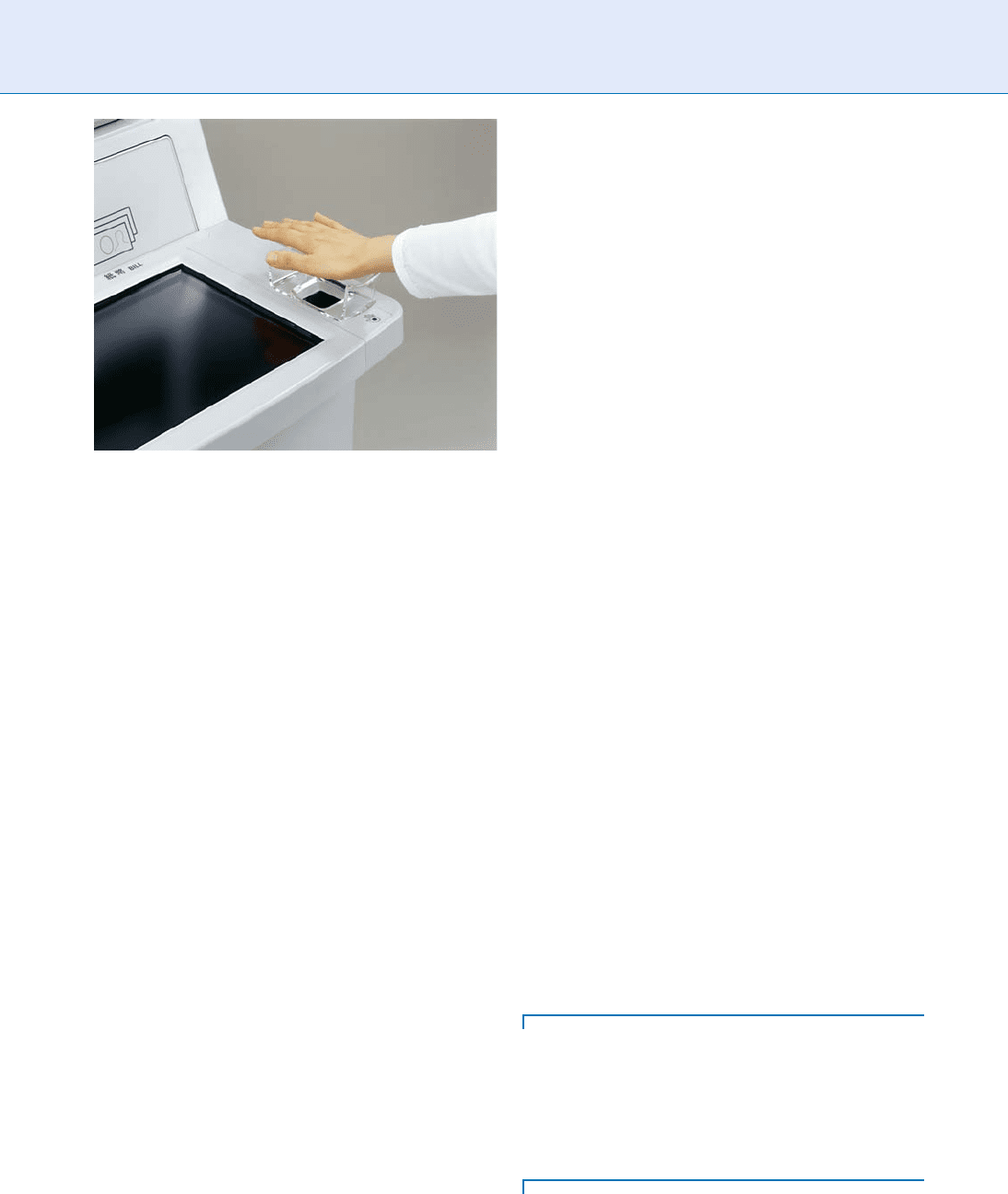
is designed to protect patients from identity theft and
insurance fraud, is a good example of utilizing the
hand guide. To implement the system, CHS developed
a unique hand guide, adapted perfectly for a hospital
environment since it incorporates a pediatric plate
for young children, and thus can accommodate all
CHS patients.
Summary
The palm vein image sensor is used for palm vein
authentication employing the vein pattern of the
palm of a person as personal identification informa-
tion. An image of the palm vein pattern is captured
using near-infrared rays in the reflection method. The
illumination device emits light with a wavelength of
around 760 nm, which is more strongly absorbed by
the deoxygenated hemoglobin in the veins compared
to the surrounding subcutaneous tissues of the hand.
The imaging device captures the whole or partial
palm area and has a sufficiently high resolution to
distinguish the vein pattern. In case of sensors using
the reflection method for capturing, those two
devices are compactly installed. The palm image sen-
sor is used for various applications and is embedded
in many different kinds of equipment, such as the
access control unit for door securit y systems, PC
mouse for login management, ATMs for financial
services, confirmation units for hospital patients,
and so on.
References
1. Kim, J.G., Xia, M., Liu, H.: Extinction coefficients of hemoglobin
for near-infrared spectroscopy of tissue, IEEE Eng. Med. Biol.
Mag. March/April, 118–121 (2005)
2. Rice, J.: Apparatus for the Identification of Individuals,
US Patent, 4, 699, 149 (1985)
3. Peterson, D.C., Jackson, D.W., Stiver, J.A: Method and appa-
ratus for subcutaneous identification, US Patent, 6,330,346
(2001)
4. Stiver, J.A. Peterson, D.C.: Identification system, US Patent,
5,793,881 (1998)
5. Snowflake Technologies, http://snowflaketechnologies.com/
Accessed 19 Mar, 2009
6. Wray, S., Cope, M., Delpy, D.T., Wyatt, J.S., Reynolds, E.O.:
Characterization of the near infrared absorption spectra of
cytochrome aa3 and haemoglobin for the non-invasive moni-
toring of cerebral oxygenation, Biochim. Biophys. Acta, 933(1),
184–192 (1988)
7. Cope, M.: The application of near infrared spectroscopy to
non invasive monitoring of cerebral oxygenation in the newborn
infant, Ph.D. thesis, University College, London Appendix D.
316–323 (1991)
8. Watanabe, M., Endoh, T., Shiohara, M., Sasaki, S.: Palm vein
authentication technology and its applications, In: Proceedings
of Biometrics Symposium, pp. 37–38 (2005)
9. Sasaki, S., Hiroaki Kawai, H., Wakabayashi, A.: Business expan-
sion of palm vein pattern authentication technology, FUJITSU
Sci. Tech. J. 41(3), 341–347 (2005)
10. NEC Corporation: NEC develops the world’s first con-
tactless multi-modal finger recognition technology (2008),
http://www.nec.co.jp/press/en/0805/1402.html. Accessed 19
Mar, 2009
11. International Biometric Group: Comparative Biometric Testing
Round 6 – Public Report (2006), http://www.biom etricgroup.
com/reports/public/reports/CBT6_ report.htm. Accessed 19
Mar, 2009
12. Wang, J.-G. Yau, W.-Y. Suwandy A. Sung, E. Person recognition
by palmprint and palm vein images based on ‘Laplacianpalm’
representation. Pattern Recogni. 41(5), 1531–1544 (2008)
Palm Vein Recognition
▶ Palm Vein
Palm Vein Scanner
▶ Palm Vein Image Sensor
Palm Vein Scanner. Figure 3 ATM with palm vein
authentication sensor.
1036
P
Palm Vein Recognition

Palmprint
Palmprint is an impression or image left on a surface
by the friction skin of the palm.
▶ Anatomy of Friction Ridge Skin
Palmprint, 3D
DAV I D ZHANG,VIVEK KANHANGAD
Biometrics Research Centre, Department of
Computing, The Hong Kong Polytechnic University,
Hung Hom, Kowloon, Hong Kong
Synonyms
P almprint authentication, 3D; P almprint recognition, 3D
Definition
Biometric systems that rely on unique features of the
palm for personal recognition are referred to as palm-
print based biometrics. A 3D Palmprint biometric
system employs 3D imaging device to acquire surfaces
of human palm and uses this data in performing user
identification. Extracted features from a 3D palmprint
data include depth and curvature of palmlines and
wrinkles on the palm surface.
Introduction
Human palmprints are rich in features that are unique
and stable. Major palmprint features include principal
lines, wrinkles, ridges, singular points, and minutiae
points (see Fig. 1). In addition, human palmprints
are also abundant with texture features. Apart from
being feature-rich, palmprints have advantages over
other hand-based biometric technologies [1, 2]:
1. Compared to the fingerprint, the palm provides
a larger surface area so that more features can be
extracted
2. An individual is less likely to damage a palm than a
fingerprint, and the line features of a palm are
stable throughout one’s lifetime
3. Small amounts of dirt or grease appearing on an
individual’ s finger may pose challenges in accurately
extracting features for a fingerprint system. This
problem does not arise in the extraction of palmprint
features since a comparative low resolution palmprint
images are used to extract these features
Most of the current works in the area of automated
palmprint recognition are based on acquiring intensity
image of the user’s palm and extracting line or texture
features from it. Although these systems have been able
to achieve promising performance with low error rates
[3], there are a few inherent limitations associated with
such systems. Firstly, they are sensitive to spurious pat-
terns such as dirt, lines or text on the palm. Performance
of the palmprint recognition systems based on intensity
images can be severely affected by the spurious patterns
on the palm. An impostor may also blemish his palm
with a purpose to circumvent the system. In addition,
like most other 2D image based personal recognition
systems, palmprint systems are also vulnerable to sensor
level spoof attacks. An impostor may easily fabricate
a spoof palm resembling a genuine user’s palm and
use to it to circumvent the system. On the other hand,
a palmprint biometric system based on 3D images of
users’ palm offers higher degree of robustness against
such attacks. These systems are extremely difficult to
circum v ent as they require sophisticated methods to fab-
ricate spoof 3D palmprint models. Another factor that
often has an impact over the performance of
Palmprint, 3D. Figure 1 Palmprint features.
Palmprint, 3D
P
1037
P

con ventional palmprint rec ognition systems is the
changes in the illumination. This, in fact is a major
problem for other biometric systems such as the one
employing users’ face images. The face images are often
requir ed to be imaged in outdoor environments and, as a
result,showlargeintraclassvariations.However,palm-
print systems often acquire images in a contr olled envi-
ronment and therefore are less affected by inconsistent
illumination.
One possible solution to overcome these limitations
is to make use of depth features of the palm surface
using a 3D imaging device. Such observations will pro-
vide information on depth and curvature of palmlines
and wrinkles on the palm surface. Comparable perfor-
mance and robustness make 3D palmprint biometric
system a good candidate for high security identification
tasks. However there has not been much research
focused on exploring the utilities of 3D palmprint fea-
ture. Therefore references on this topic are limited.
3D Palmprint Recognition System
A 3D palmprint based personal recognition system
includes the following modules:
1. 3D palmprint imag e acquisition device
2. Extraction of Region of Interest (ROI) to obtain the
central part of the palmprint
3. Feature extraction
4. Feature matching, where extracted features are
matched with their respective feature templates
stored during enrolment phase, generating a simi-
larity score. In identification applications, the
query template is matched to all templates enrolled
in the database. Therefore, a one-to-many com-
parison is performed in this case
5. Decision module, where the similarity score pro-
duced is compared to the threshold of the system
to either accept or reject the identity claim. In iden-
tification applications, identity of the user is deter-
mined to be the one with highest similarity score
3D Palm Image Acquisition
Infrared sensors are employed to detect the presence of
the hand on the acquisition device. When a hand is
detected, the device projects multiple light patterns
onto the palm surface and acquires depth information
using active triangulation. In order to distinguish be-
tween stripes, they are coded with different brightness.
The system uses a computer controlled liquid crystal
display (LCD) projector that can generate arbitrary
stripe patterns. A CCD camera is used to acquire the
images formed on the palm side. The sequence of
images acquired by the CCD camera is then processed
to obtain the 3D palm data. Figure 2a shows the
process of acquisition of 3D palmprint data using a
3D image acquisition device based on structured
light principle. The US patent [4] describes the pro-
cess of acquisition of 3D finger and palmprint infor-
mation using multi-camera and light projection
system. This device projects multiple structured lights
from different directions and the images formed on
the object (palm or finger) are captured by cameras at
different angles. It is claimed that the system can
simultaneously obtain 3D fingerprint and palmprint
information.
Feature Extraction
Acquired 3D images are processed to extract the region
of interest (ROI). The inter finger points are used as
reference points to extract a sub image of fixed size
located at the center part of the palm. These 3D sub
images are further processed to extract surface curva-
ture features. To represent the curvature of every point
on the 3D palmprint image by a scalar value, the
curvedness (C) introduced in [5] is utilized. The posi-
tive value C is a measure of how sharply or gently
curved, a point is [6]. It is defined in terms of principal
curvatures k
1
, and k
2
, as:
C ¼
ffiffiffiffiffiffiffiffiffiffiffiffiffiffiffiffiffiffiffiffiffiffiffi
ðk
2
1
þ k
2
2
Þ
=
2
q
ð1Þ
The principal curvatures k
1
and k
2
can be deter-
mined as:
k
1
; k
2
¼ H
ffiffiffiffiffiffiffiffiffiffiffiffiffiffiffiffi
H
2
K
p
ð2Þ
where K and H are Gaussian and mean curvatures
respectively. For a surface patch represented by
Xðu; vÞ¼ðu; v; f ðu; vÞÞ, the values of K and H are
computed as follows:
KðXÞ¼
f
uu
f
vv
f
2
uv
ð1 þ f
2
u
þ f
2
v
Þ
2
1038
P
Palmprint, 3D
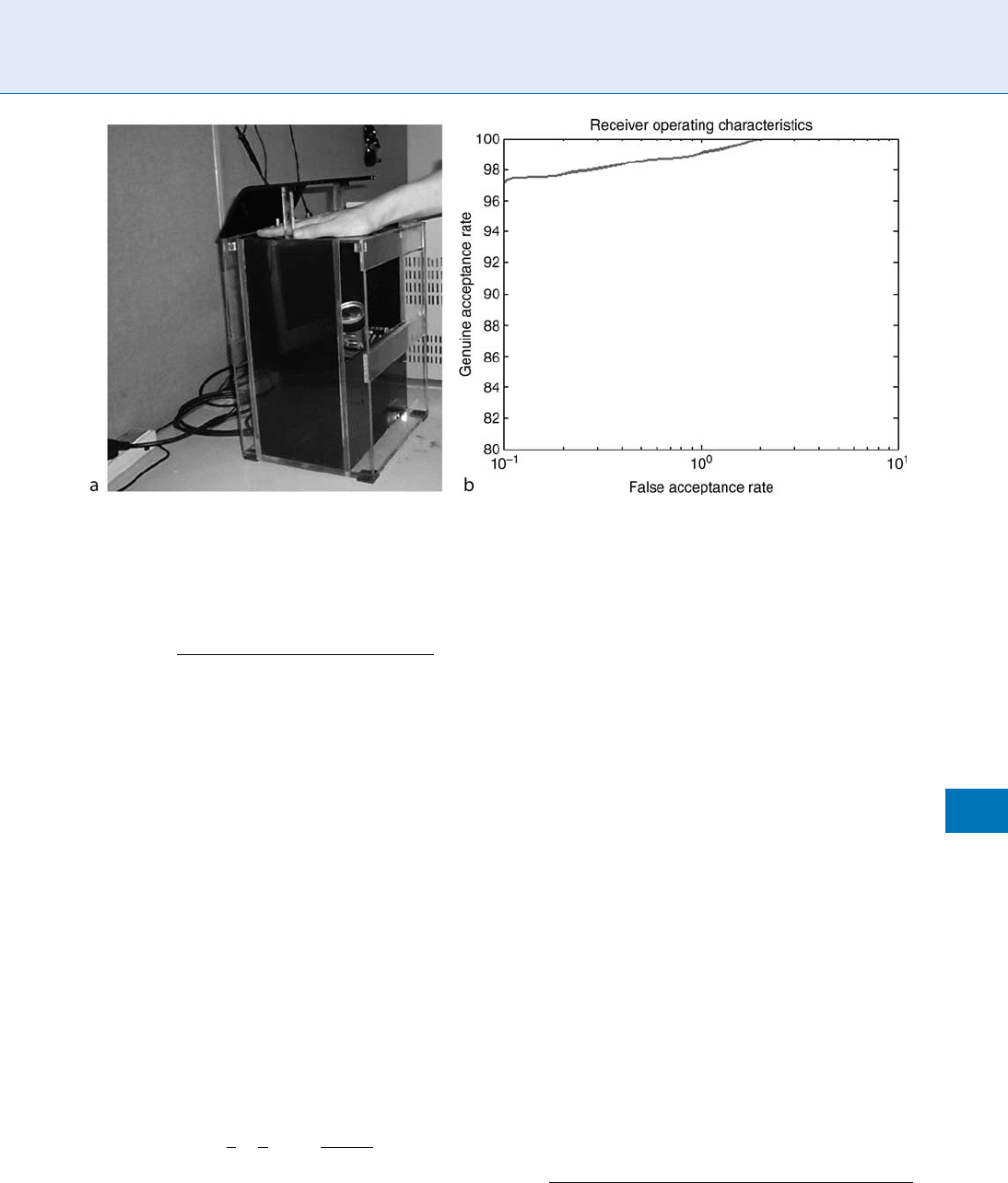
and
HðXÞ¼
ð1 þ f
2
u
Þf
vv
þð1 þ f
2
v
Þf
uu
2f
u
f
v
f
uv
ð1 þ f
2
u
þ f
2
v
Þ
3=2
ð3Þ
where, f
u
; f
v
and f
uu
; f
vv
; f
uv
are first and second order
partial derivatives of f ðu; vÞ:
The scalar value of curvature (C) is obtained
for every point on the 3D palmpri nt image and this
can be stored in a 2D matrix or an image. Set of such
scalar values is referred to as surface curvature map.
Figure 3 shows sample 3D palmprint images and corre-
sponding curvature maps. It can easily be observed
that the surface curvature maps closely resemble the
palmlines, especially the strong principal lines.
Additional features such as surface types that are
characterized using the sign of mean and Gaussian
curvature [7], shape index [8], computed using mini-
mum and maximum curvature values; may also be
explored as feature representations for the 3D palm-
print images. Shape index, a local feature computed at
each point, is defi ned as:
S ¼
1
2
1
p
arctan
k
1
þ k
2
k
1
k
2
ð4Þ
The value of shape index S lies in the interval [0,1] and
can be used to classify each point on the surface to
different surface types ranging from spherical cup
to spherical cap.
Another approach to perform user authentica-
tion is to extract 3D palmlines from the acquired
3D palmprint images and match these lines (set of
points) using point set alignment algorithms such as
iterative closest point (ICP) [9]. ICP can be employed
to iteratively estimate the transformation between the
two 3D palm lines. Alignment error (e.g., mean
squared distance) generated by the ICP can be used
as the matching score.
Feature Matching
Feature matching establishes the similarity between
two 3D palm print imag es. An image matching tech-
nique, normalized local correlation can be employed to
compare two curvature maps. Result of this matching
is a correlation value for every point in the input
curvature maps. Average of these correlation values is
considered to be the matching score. The expression
for normalized local correlation is given by:
C ¼
P
N
i¼N
P
N
j¼N
ðP
ij
PÞðQ
ij
QÞ
ffiffiffiffiffiffiffiffiffiffiffiffiffiffiffiffiffiffiffiffiffiffiffiffiffiffiffiffiffiffiffiffiffiffiffiffiffiffiffiffiffiffiffiffiffiffiffiffiffiffiffiffiffiffiffiffiffiffiffiffiffiffiffiffiffiffiffiffiffiffiffiffiffiffiffiffiffiffiffiffiffiffiffiffiffiffiffiffiffiffi
P
N
i¼N
P
N
j¼N
ðP
ij
PÞ
2
"#
P
N
i¼N
P
N
j¼N
ðQ
ij
QÞ
2
"#
v
u
u
t
ð5Þ
Palmprint, 3D. Figure 2 (a) Example 3D palmprint image acquisition system. (b) Receiver Operating Characteristics
(ROC) curve for a 3D palmprint authentication system.
Palmprint, 3D
P
1039
P
